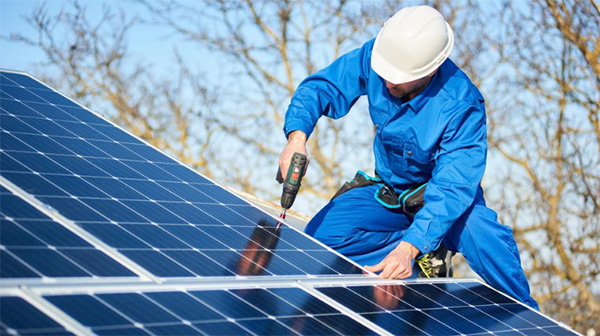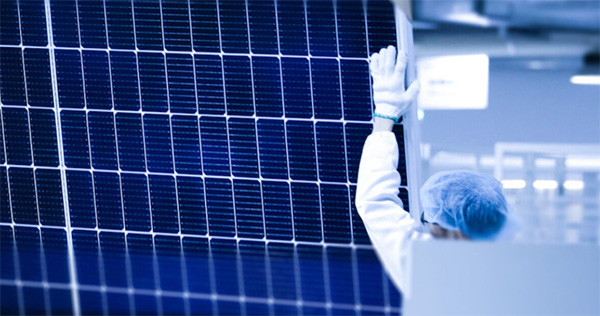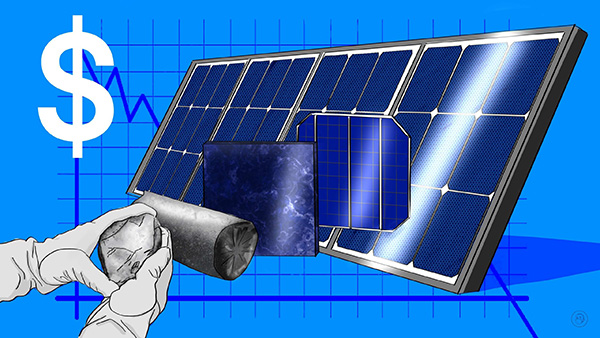Description
Polycrystalline solar panels typically last between 25 to 30 years.
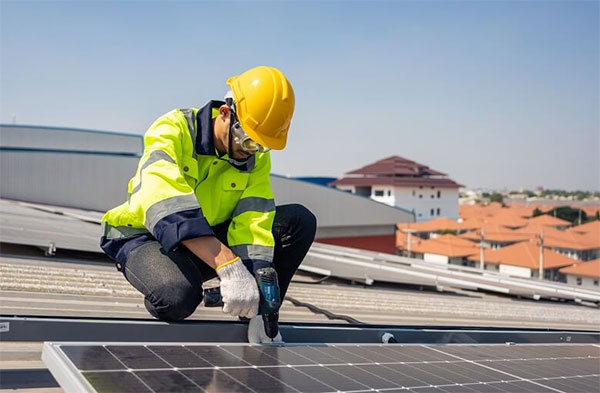
Manufacturing Process of Polycrystalline Solar Panels
Raw Materials and Production
Polycrystalline solar panels primarily rely on silicon, a material known for its remarkable photovoltaic properties. Delving into the production process unveils these specific steps:
- Silicon Extraction: Silicon, a major component, is predominantly extracted from sand. Its outstanding photovoltaic properties make it an ideal candidate for solar panel production. Silicon stands as the backbone of this manufacturing process.
- Melting: The silicon undergoes a melting process at an exacting temperature of around 1,414°C. Maintaining this temperature consistency is vital as it dictates the eventual efficiency of the panel. For polycrystalline panels, this efficiency ranges between 15% to 17%.
- Molding: Next, the liquid silicon pours into square molds, providing polycrystalline panels their characteristic square appearance.
- Cooling: A structured cooling process succeeds the molding, emphasizing a uniform crystalline structure essential for optimal solar absorption.
- Slicing: Post solidification, the silicon block is sliced to create thin wafers. These wafers, typically around 200 micrometers thick, act as the foundation for the photovoltaic cells.
- Costing: Polycrystalline panels offer an economical edge in their production phase. Their manufacturing leans towards affordability, with costs hovering between $0.20 to $0.25 per watt.
Key Differences from Monocrystalline Panels
Distinguishing between polycrystalline and monocrystalline panels can be better understood through the following comparative table:
| Feature |
Polycrystalline |
Monocrystalline |
| Appearance |
Blue hue |
Dark/black |
| Efficiency |
15% to 17% |
18% to 20% |
| Production Cost |
$0.20 to $0.25 per watt |
$0.25 to $0.30 per watt |
| Space Requirement |
Larger |
Smaller (for the same power output) |
| Lifespan & Degradation |
25-30 years with 0.7% degradation annually |
25-30 years with 0.5% degradation annually |
| Pros |
Lower cost |
Higher efficiency and compactness |
| Cons |
Slightly lower efficiency and more space requirement |
Elevated cost |
To truly grasp the intricacies between these solar panel types, it's beneficial to delve deeper into sources that detail the properties and performances of
Polycrystalline and
Monocrystalline materials.

Factors Affecting the Lifespan of Polycrystalline Solar Panels
Environmental Conditions
Environmental elements play a pivotal role in determining the longevity of polycrystalline solar panels. Direct exposure to harsh sunlight, fluctuating temperatures, and heavy snowfall can influence their efficiency. For instance, panels that experience extreme temperature changes, swinging between -20°C to 40°C, might suffer a 10% reduction in their output capacity over a decade.
Quality of Manufacturing
The quality of materials used and the precision in the manufacturing process can make a significant difference in a panel's lifespan. Top-tier manufacturers often utilize high-grade silicon and implement stringent quality checks, ensuring panels have an efficiency rate of up to 17% and a life expectancy surpassing 25 years. Conversely, subpar manufacturing can reduce panel life to merely 15 years with an efficiency decline of 1% annually.
Regular Maintenance and Cleaning
Maintenance impacts the performance and lifespan of solar panels. Dirt, debris, and bird droppings can accumulate on the panel's surface, causing up to a 5% efficiency loss if not cleaned regularly. A routine check every six months, coupled with annual professional maintenance, can keep panels operating at their optimal capacity, extending their effective lifespan.
Potential Degradation Factors
Every solar panel undergoes degradation, a decline in its output capacity over time. Polycrystalline panels typically degrade at a rate of 0.7% per year. Factors accelerating this include micro-cracks, potential induced degradation (PID), and light-induced degradation (LID). For instance, PID can lead to a 30% reduction in a panel's output over its lifetime. Familiarizing oneself with
PID and
LID can provide insights into measures for countering such degradation effects.

Average Lifespan and Performance Over Time
The sustainability and long-term profitability of solar panel investments hinge largely on their lifespan and performance degradation over time. When purchasing and installing solar panels, understanding these aspects ensures a balance between efficiency and cost-effectiveness.
Efficiency Drop Over the Years
One of the critical factors impacting solar panel investment is the rate at which their efficiency drops. For standard photovoltaic panels, there is an annual efficiency decrease. Studies indicate that monocrystalline silicon panels experience an average efficiency reduction of 0.5% to 0.8% per year. For a solar panel with an initial output of 20%, this translates to only about a 14%-16% efficiency after 25 years, which is a standard performance guarantee period.
Factors contributing to performance depreciation include:
- Material Degradation: The wear and tear of materials, often exacerbated by harsh weather conditions, can cause micro-cracks and corrosion.
- UV Exposure: Extended exposure to ultraviolet (UV) rays can induce photo-degradation, reducing the panels' operational capabilities.
- Temperature Fluctuations: Frequent changes in temperature can cause thermal cycling, leading to physical stresses on the panels.
To maximize efficiency and mitigate the drop over time, regular maintenance, and appropriate installation locales are imperative. Additionally, considering the potential degradation helps in accurate financial forecasting, ensuring the venture remains beneficial within the budget constraints.
Comparing Lifespan with Other Types of Solar Panels
In assessing the value proposition of different solar technologies, their lifespans provide insight into their long-term viability and associated costs. Here is a comparison of various solar panel types, highlighting their average lifespans:
| Type of Solar Panel |
Average Lifespan (Years) |
Pros |
Cons |
Efficiency (% at Peak) |
| Monocrystalline Silicon |
25-30 |
High efficiency; Long lifespan; Space-efficient |
Higher cost; Sensitive to high temperatures |
15-20 |
| Polycrystalline Silicon |
23-27 |
Lower cost; Less energy-intensive manufacturing process |
Lower efficiency; Shorter lifespan; Larger space requirement |
13-16 |
| Thin-Film |
20-25 |
Cheapest option; Flexible applications; Performs well in hot conditions |
Shortest lifespan; Requires more space; Less efficient |
11-13 |
| Concentrated PV Cell (CPV) |
25-30 |
Very high efficiency; Low environmental impact |
Highest cost; Requires sun-tracking system; High installation complexity |
35-40 |
These details illustrate that while factors such as initial price and efficiency at installation are essential, the lifespan and performance over time significantly influence the real value and return on investment. By understanding these specifics, buyers and investors can make informed decisions based on comprehensive cost, efficiency, and the value derived throughout the panels' operational periods.
Maintenance and Care to Extend Lifespan
Maximizing the operational lifespan of solar panels is not just about choosing the right product; it requires a consistent maintenance routine. Proper care helps preserve the panel’s efficiency, prevents unforeseen costs, and ensures a steady production of electricity, enhancing the overall value of the initial investment.
Routine Inspection and Cleaning
Regular inspections are paramount in preempting potential issues. A bi-annual inspection is advisable, though areas with frequent inclement weather might require more regular checks.
During inspections, look for:
- Dirt and Debris Accumulation: Ensure the panels are clean. Dust, leaves, or snow can reduce the efficiency by blocking sunlight. According to research, cleaning solar panels can lead to a 3-5% increase in efficiency annually. The cost of cleaning by professionals can range from $15 to $35 per panel, a worthwhile investment compared to potential energy loss.
- Wiring Issues: Check for loose, hanging, or bitten (by animals) wires, which could impact the system's safety and performance.
Professional services might use drones for larger installations, providing detailed aerial imagery that can identify hidden faults, at an average cost of $150 to $300 per inspection, depending on the size of the solar panel system.
Addressing Minor Damages and Repairs
Timely intervention on minor damages prevents escalation into more significant issues that could heavily impact costs and efficiency. Common concerns include:
- Micro-cracks: Resulting from physical impacts, temperature fluctuations, or manufacturing defects, they can reduce the overall efficiency. While individual micro-cracks might not be immediately detrimental, they can worsen over time.
- Hot spots: These occur when a part of the panel generates higher resistance than the rest, affecting power output and potentially leading to failures. Immediate repair of hot spots is crucial to prevent further panel damage.
- PID (Potential Induced Degradation): This refers to the loss of power due to stray currents triggered by voltage differences between the solar cells and the ground. Special equipment can reverse PID, with services costing around $500 to $1,000 for a residential system.
Addressing these issues might involve enlisting a specialist whose services could range from $100 to $300 for minor repairs.
Upgrades and Replacements
Even with meticulous care, components of the solar panels will need upgrading or replacement over time.
- Inverters: These typically have a shorter lifespan (10-15 years) compared to panels. A good quality inverter will cost between $1,000 and $2,000, excluding installation charges.
- Solar Cells: Technological advancements might make it tempting to upgrade to more efficient cells. However, it’s crucial to weigh the benefits against the cost, which could be substantial.
- Batteries (for off-grid systems): Solar batteries, depending on their type and usage, last between 5-15 years. Replacement costs vary widely, with modern lithium-ion batteries costing between $2,000 and $8,000.
Careful consideration of each component's age, efficiency, and potential technological advancements is necessary before any replacements or upgrades, keeping in mind the overall budget and expected performance enhancements.
In conclusion, maintaining solar panels to extend their lifespan involves a proactive approach in routine inspection, timely repairs, and strategic upgrades. These actions contribute significantly to the system’s uninterrupted productivity, financial savings, and efficiency over the years, ensuring the sustainability of this renewable energy investment.
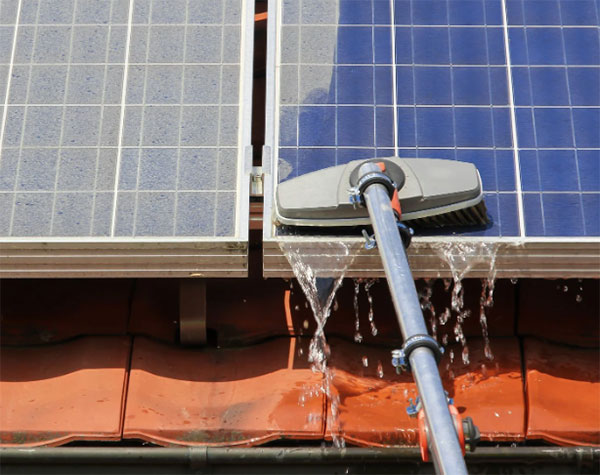
Economic Implications of Panel Lifespan
The economic aspects of solar panel investments stretch far beyond the initial costs. From the return on investment (ROI) to the potential resale value and the comprehensive cost-benefit analysis over the panels' operational life, various factors influence the financial wisdom behind solar energy investments.
Return on Investment (ROI) Over Time
The ROI for solar panels is a critical figure for both residential and commercial investors. It's essential to calculate the break-even point, considering factors such as the initial investment, maintenance costs, and energy savings. For instance, with an average initial setup cost of $15,000 to $25,000 for a residential unit, coupled with minimal annual maintenance costs of around $300, the savings on electricity bills need scrutiny.
Given that an average household can save approximately $1,000 to $2,000 annually on electricity, the break-even point might occur within 7 to 12 years, post which pure savings could range from $13,000 to $25,000 by the end of the standard 25-year lifespan. These calculations can vary based on local electricity rates, the amount of sunlight, and government incentives such as tax breaks or
feed-in tariffs.
Resale Value of Aged Polycrystalline Panels
While solar panels enhance property value, the resale worth of the panels themselves, especially polycrystalline, often decreases over time. A decade-old solar panel system might only recoup 10% to 20% of the initial investment cost during a property sale.
The depreciating resale value is due to several factors:
- Efficiency Degradation: With efficiency dropping approximately 0.5% to 0.8% annually, a 10-year-old panel operates at around 86% to 92% of its original capacity.
- Technological Advancements: Newer models are often more efficient and come with advanced features, making older panels less competitive.
- Remaining Lifespan: Buyers might be hesitant to invest in used panels with a reduced operational life expectancy.
Considering these aspects, selling used polycrystalline panels is more about offsetting new investment costs rather than making a profit.
Cost-Benefit Analysis over Panel's Lifespan
Conducting a comprehensive cost-benefit analysis requires considering all monetary factors throughout the solar panels' lifespan. Apart from initial setup costs and expected energy savings, this analysis should factor in maintenance expenses, potential tax credits, financing costs, and the aforementioned resale value.
For a solar panel system costing $20,000 initially, one might factor in additional lifetime costs of up to $5,000 for maintenance and repairs. Savings, on the other hand, could tally up to $40,000 over 25 years, considering energy rates, efficiency degradation, and potential revenue from surplus energy generation. When adjusted for the potential $3,000 to $4,000 resale value or recouping costs from aged panels, the net benefit stands significantly positive.
However, these figures can shift based on energy prices, which are subject to change due to market and regulatory influences, and unexpected repair or replacement costs, emphasizing the need for a cushion in the initial budget projections.
In conclusion, understanding the economic implications of a solar panel system’s lifespan is crucial in making an informed investment decision. It requires a holistic view of various financial elements, ensuring the venture is profitable in the long run while contributing to sustainable and renewable energy development.





